Is your ecommerce site search and product discovery experience not meeting expectations? It’s among the most significant factors that drive key business KPIs. With the pandemic enabling a historic and likely permanent shift in consumer behavior to online and mobile digital channels, internal site search continues to gain importance.
In such an environment, even the world’s biggest retailers have to adopt certain site search practices to improve their KPIs and customer experiences for shoppers.
Here are five best practices to implement on your internal site search:
- Prioritize Attractiveness over Relevance
- Personalize Site Search Results for Individuals
- Provide Effective and Transparent AI Tools
- Enable Robust Merchant Tooling
- Improve Autocomplete
1. Prioritize Attractiveness over Relevance
Historically, merchandisers and search architects focused on ensuring their search results were “relevant.” However, this is not the only way companies like Amazon and Google evaluate their search, as relevance is only one factor in providing customers with choices they actually want.
The problem with relevance is its subjectivity. It’s not a clear, measurable goal the business can optimize for. If a user searches for “laptops” on an electronic retailer’s website, they certainly wouldn’t benefit from seeing laptops from 2009 listed in the search results. However, those results are still technically relevant.

Another issue is that relevance typically focuses on the search string itself and not the user intent. Not knowing the latter can lead to search engines providing results that are technically accurate but not appealing. For example, if a user looks for “chips” and is highly likely to buy Cheetos, they should be shown Cheetos as well. Some older search engines may pedantically disagree with the user and only offer products with “chips” somewhere in the title (including chocolate chips or wood chips), leading to user dissatisfaction.
Questions like these aren’t fully answered by optimizing site search for relevance. It just isn’t the best way to serve customer and business needs. So what else should merchandisers optimize search results for in addition to relevance?
The answer is attractiveness.
A balanced combination of relevance, attractiveness, and personalized attractiveness ensures that customers get what they actually want.
- Relevance ensures that shoes won’t show up when a customer searches for a laptop.
- Attractiveness ensures that the laptops most likely to be purchased from that search turn up.
- Personalized attractiveness optimizes for the needs and wants of the user based on their clickstream data.
Combining these factors surfaces results that the customer is most likely to buy. And by displaying said results in the optimal order, the business can increase the KPIs it cares about most.
By optimizing your site search for specific KPIs, Constructor tools are able to generate attractive search results that benefit both you and your users. For instance, on KMart Australia’s website, typing “chips” shows “Cheetos” because Constructor understands that users who buy chips are also likely to find Cheetos attractive.
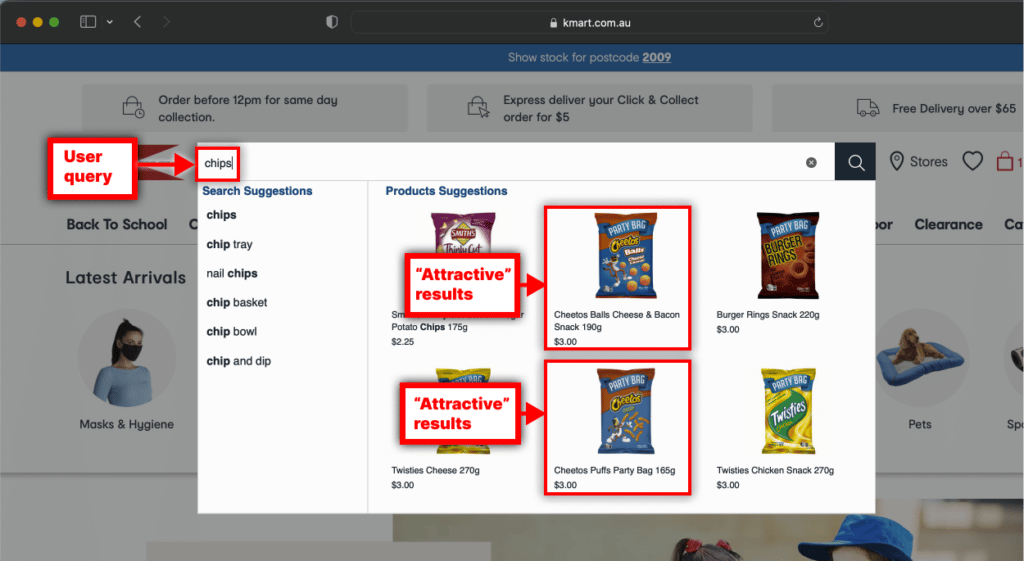
2. Personalize Site Search Results for Individuals
91% of ecommerce customers prefer to shop with brands which recognize, remember, and provide relevant offers and recommendations. And 83% of customers are willing to exchange their data for a personalized experience.
Clearly, customers love being given an experience that makes them feel cared for. Attractiveness improves search results based on business KPIs, but personalizing them for each user makes them irresistible. For example, Target Australia achieved a 14.8% lift in search purchase rates by personalizing and reranking results with Constructor’s machine learning tools, among other techniques.
Great product discovery systems take the idea of relevance vs. attractiveness and apply it on a user-by-user basis using first-party data. Once you have enough data about a specific user’s preferences, you can begin ranking products specifically for that user to give you the best chance of increasing your business KPIs (like conversions).
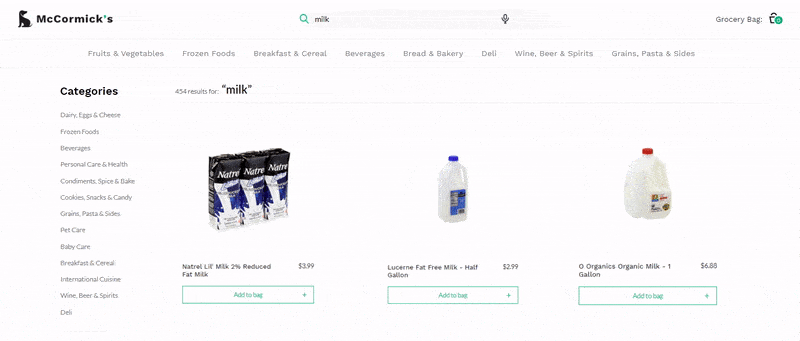
With so much user-provided data, search results should be hyper-personalized from the moment customers start navigating your site. You can apply this strategy in most places on your site, including category pages and even in navigation:

3. Provide Effective and Transparent AI Tools
Wherever retailers look, they’re being offered “AI-driven” ecommerce tools that don’t actually use machine learning and results that don’t come through as promised. What’s worse, these tools are often “black boxes” that don’t allow merchant teams to see or adjust how (or whether) their results are being improved. An effective AI-driven search tool should both be truly effective and transparent about how it’s achieving its results.
Here are some of the ways that machine learning and AI can solve common search problems:
Reduce frustrated and zero-result searches
Constructor improves search results with Cognitive Embeddings Search by massively reducing frustrated and zero-result searches.
A recent study of 123 ecommerce sites showed that “a whopping 70% of the search engines are unable to return relevant results for product type synonyms.”
This is a common problem among many older search systems, which leads to unhappy users either leaving the site or refining their search. If 500 users on your site search for “sun block” and 90% of them leave the page immediately after, that query is shown to merchandisers as a frustrated search.
These older systems show merchandisers the queries that users refine their searches to and the queries they convert on (for instance, “sunscreen”) but can’t fix these issues automatically. So merchandisers have to manually set synonyms and redirects to solve those frustrated searches. This is very tedious and time consuming for them.
But the addition of effective and transparent AI like Cognitive Embeddings Search significantly improves the problem of both frustrated and zero-result searches automatically. A discovery platform that relies on true machine learning and natural language processing can dramatically reduce the zero-results rate and positively impact key metrics like search conversion rate and number of reformulated searches. It does this by intelligently mapping the relationships between terms to give “best fit” results every time.
For instance, it can recognize the relationship of the user query “sun block” with products with names like “sunguard” or “sunscreen” and display related results accordingly

AI transparency
All the high-tech AI tools in the world don’t mean much if merchandisers can’t understand why the AI is making certain decisions on their behalf. A transparent AI platform like Constructor shows merchandisers exactly which factors are causing products to be boosted or buried while giving humans full control over what users actually see based on business needs.
This AI transparency allows businesses to provide the best possible choices for customers by combining advanced processing and predictive insight through AI and the human expertise of merchandisers themselves, who know their customers better than anyone.
Does it work? This transparency and the great relationship it fostered between Constructor and home goods retailer Rugs Direct dramatically improved Revenue Per Visitor and Average Order Value KPIs.
“Other vendors claimed that they had AI capabilities, but either it wasn’t clear where the technology was applying their learnings, or AI was slated somewhere far down on the roadmap,” said Sharon Gautschi, VP of Marketing. “AI is inherent in the foundation of Constructor’s technology and they demonstrated that they could align their tool with the business KPIs that I cared about.”
Leaning into transformers
Clickstream-based product discovery that focuses on optimizing for attractiveness and business results is state-of-the-art. It’s also available to large enterprise retailers and has been for the past few years.
The newest cutting-edge solutions are still using clickstream data but also leaning into transformers (the “T” in ChatGPT) and large language models (LLMs) to power the product discovery experience. Some early experimentation shows that training transformers on ecommerce data (like customer clickstream and product attributes) leads to even more attractive and personalized results, with A/B tests outperforming state-of-the-art solutions.
While this technology is still new, it’s incredibly promising and exciting. As we move into a “ChatGPT” era, we predict that working with a product discovery partner that is familiar and innovating on these technologies will be a competitive advantage.
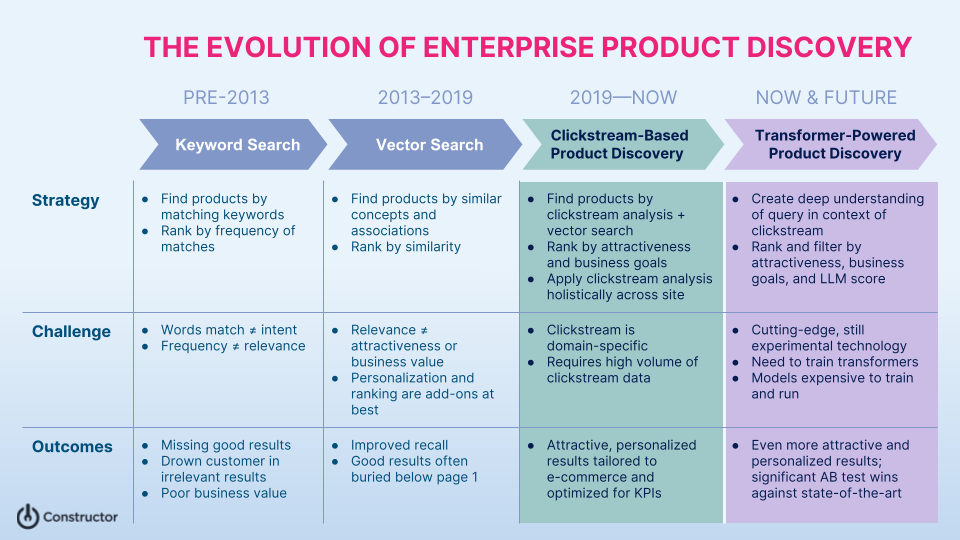
4. Enable Robust Merchant Tooling
Good internal site search should allow the merchant to optimize for a KPI by strategically placing high-value items within search results. This combination of merchandising and search is called “searchandising.” Merchants using a robust search solution should have a series of tools at their disposal to boost, bury, block, and group inventory in creative ways to provide results that serve both customer needs and business KPIs. These tools can free merchandisers from having to manually re-rank products and instead focus on easy merchandising by exception.
Boost new or own-brand products
If you have a new product or an own-brand product that you’d like to advertise to users, merchant tools should allow merchandisers to quickly slot those items in the top position for queries relating to the item. For example, if a merchant that sells auto parts has a new stock of a particularly effective new motor oil, they can boost that item for all queries related to motor oil.
Boost high-margin/low-inventory products
Merchants can also boost products that generate high profit margins or products with high inventory you’re looking to move. For instance, if merchandisers see that sales of summer clothes have been slower than expected, they can boost them for maximum sales before fall arrives.
While manually boosting these products can be great for driving impactful business metrics (like high-margin unit sales), it’s important that your platform is able to monitor and surface conversion metrics after altering search results for any query. Some manually boosted products can negatively impact your search experiences, thereby hurting your KPIs.
Boost/bury rules around availability or arrival dates
Merchants can apply automatic boost and bury rules to products based on their availability, like boosting in-stock or high-inventory products and burying out-of-stock products. They can also boost and bury products that haven’t arrived yet, provided they’re listed on the website.
For instance, if a merchant sees a lot of pre-orders or market interest for a new version of a popular brand of hiking boots while still having a large stockpile of the old version, they can temporarily boost the old model and bury the new model to move the remaining inventory while stocking up.
Provide effective blocklisting
Sometimes merchandisers can mistakenly display out-of-stock products or incorrect pricing, which forces them to reupload the entire catalog from scratch. They might also want to block inappropriate products for specific user segments (for example, preventing alcoholic beverages being displayed to children).
An effective blocklisting solution gives you the power to quickly block products or groups of products, allowing further customization and personalization of results to fit user needs and business KPIs.
Create custom timed collections
Some merchant tools allow you to quickly create customized collections like themed products around holidays or special events to show to users when they search for specific queries. If a user searches for “birthday gifts” on your site, you could redirect them to a collection based around birthday gifts.
In the real world, our customer Backcountry received a +8% boost in RPV in just two months on its Competitive Cyclist property. Backcountry, along with two of its sister sites, achieved these results by using our Collections tool along with our Search and Recommendations tools.
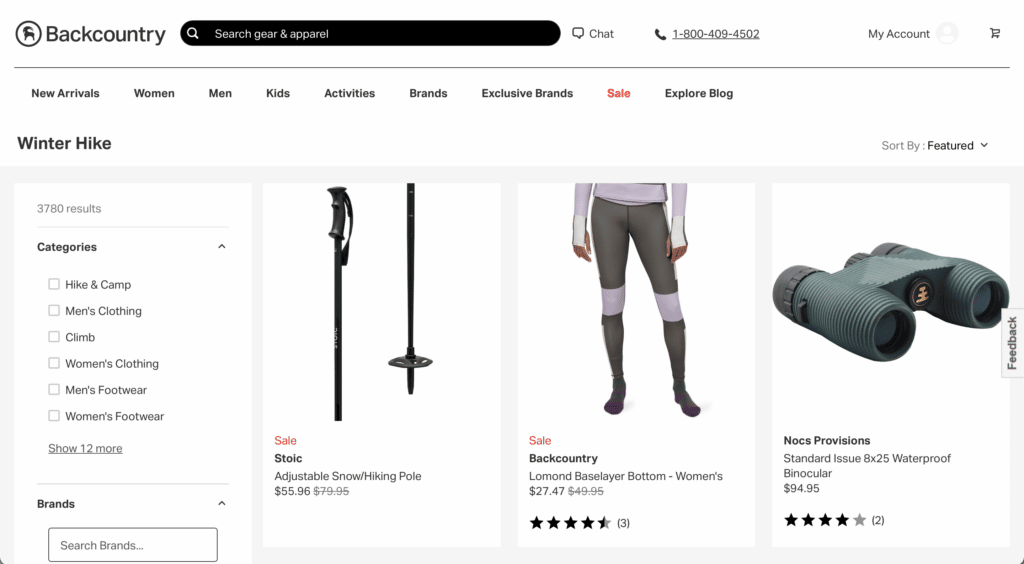
5. Improve Autocomplete
These days, autocomplete is a site search best practice provided by most if not all search engines, both within and outside of the ecommerce space. At its simplest, autocomplete helps users search for products faster by predicting their queries and recommending completed queries. Studies have shown that search autocomplete can boost sales by 24%.
But at Constructor, our Autosuggest tool solves for much more than basic autocomplete.
Correct misspellings
Great autocomplete corrects phonetic misspellings, keyboard proximity typos, punctuation nuances, and omitted character typos. Is it “jumpsuite,” “jmpsuts,” or “jumpsuit?” It’s officially spelled “jumpsuit,” but Constructor Autosuggest doesn’t require users to know this to get good results.
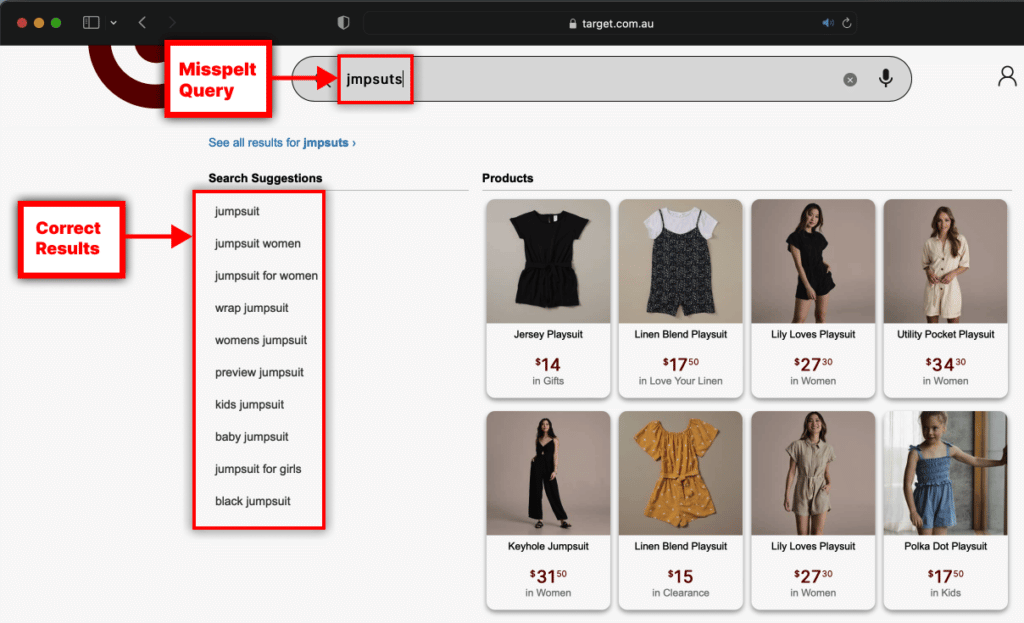
Detect synonyms
Great autocomplete should also detect synonyms within the query to serve autocomplete results. For instance, if a user types “pop,” the autocomplete system should detect and display synonyms like “soda,” “cola,” and more.
Rank words by importance
A good site search system should be able to recognize and prioritize the important keywords in a query and serve recommendations based on those words.
For instance, if a user searches for “sleek red dresses for women,” the system should know that “sleek,” “red,” and “dresses” are the most important keywords.
Show products in search bar
On top of helping users search for products with Autosuggest, you can embed products within the search bar to give a “visual autocomplete”:
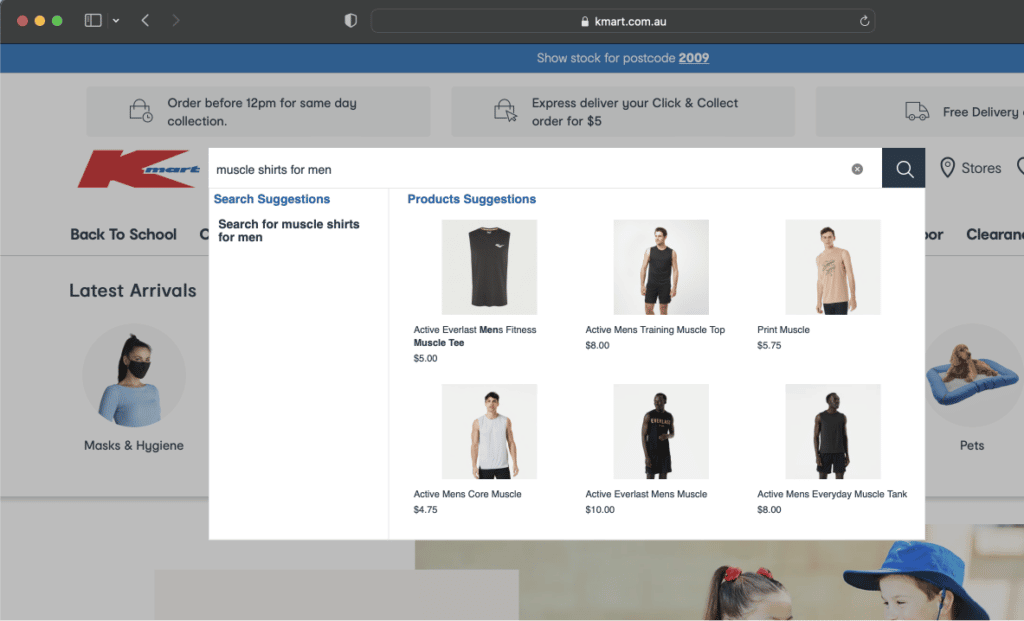
Our own data tells us that users are twice as likely to convert on products they’ve clicked from embedded product listings.
Next Generation Ecommerce Internal Site Search
Internal site search creates a better customer experience, but only the most forward thinking retailers are also able to leverage it as a competitive advantage. With the right ecommerce site search tools in place, you’ll see improved KPIs like conversion rates, search revenue, revenue per visitor, and more. By optimizing site search and providing effective and transparent AI tools, Constructor will bolster your KPIs and provide a better shopping experience for customers.
Need help optimizing your search experience for business KPIs and attractive results for users? Constructor’s AI-backed product search and discovery platform will help personalize your customer experience and generate lifts in the metrics that matter most. Learn how Constructor works and request a demo today.

